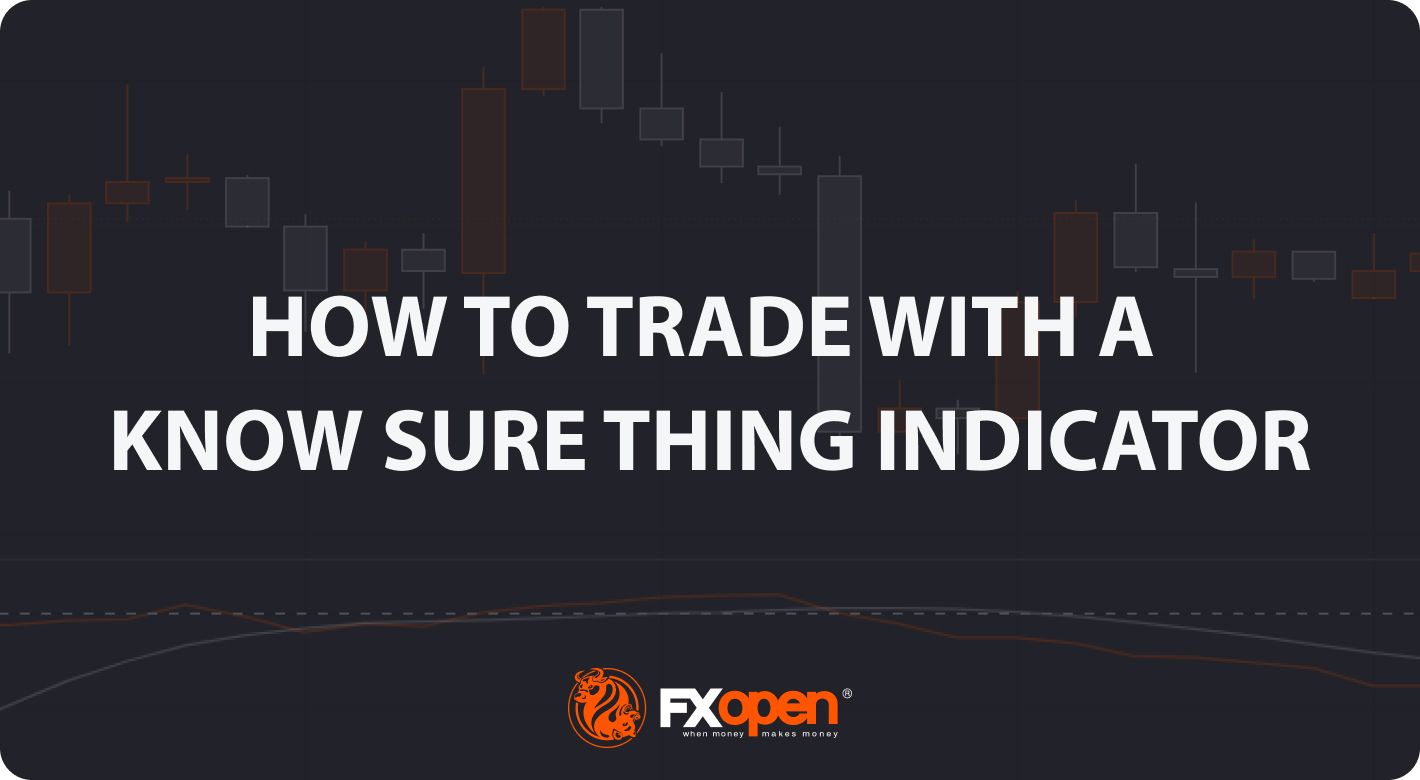FXOpen

As every decision counts when trading in a fast-paced financial environment, confirming a move to buy or sell using indicators may be a safer strategy for gaining an edge. KST is an important tool that you can apply when trading to check current trends, develop new trading signals, and analyse trend reversals. This FXOpen article provides a detailed exploration of how to adopt a KST indicator trading strategy.
What Is a Know Sure Thing (KST) Indicator?
In the financial markets of changing trends, technical analysis can help you make informed trading decisions. The Know Sure Thing indicator is a viable option among the various technical indicators available. You may ask, “What is a KST indicator?” It is a momentum indicator with two lines of varying colours that move up and down around the zero line. The KST measures the price momentum of four rates of change (ROC) calculations to create a composite indicator. Each ROC uses different periods, allowing it to incorporate multiple timeframes to present a more reliable picture of the underlying trend. It also minimises short-term fluctuations as well as price noise.
How to Calculate the Know Sure Thing (KST) Indicator
The KST is based on the weighted average of four smoothed ROC values. You can calculate it by taking simple moving averages (SMA) of ROCs with four different periods, multiplying each by a figure from 1 to 4 and adding them up. Use these equations for this calculation:
KST = (RCMA #1 × 1) + (RCMA #2 × 2) + (RCMA #3 × 3) + (RCMA #4 × 4)
Where:
RCMA #1 = 20-period SMA of 10-period ROC
RCMA #2 = 20-period SMA of 15-period ROC
RCMA #3 = 20-period SMA of 20-period ROC
RCMA #4 = 25-period SMA of 30-period ROC
The indicator also includes a signal line that is calculated as the following:
Signal line = 9-period SMA of KST
Taking the four ROC settings, ROC indicators’ moving averages, together with a signal line, the resulting parameters of the KST are 10, 15, 20, 30, 20, 20, 20, 25, and 9.
How to Use a KST Indicator Strategy
There are several strategies for using a KST.
Trend Reversals
With KST, you can identify a potential trend reversal. A trend may turn upwards when the indicator crosses above the zero line. In contrast, it may turn downwards when the indicator crosses below the zero line.
However, as the indicator consists of two lines, their crosses can also be used to identify the price direction. When the KST (green) crosses below the signal line (red), this may suggest a likely shift from bearish to bullish momentum. Also, when the indicator line breaks above a signal line, it suggests a potential upward move.
Check this image for a vivid illustration.
Divergence
A divergence occurs when an asset’s price tends toward a direction different from that of the indicator. When this happens, it signifies that the current trend is losing its momentum. A bullish divergence occurs when the KST line makes higher lows while the asset price makes lower lows. This may signify a likely bullish reversal, as the bears are losing power, and the bulls may be ready to control the market again.
Similarly, a bearish divergence occurs when the KST makes a lower high while the asset price makes a higher high. Bulls may lose power, while the bears are ready to control the market again.
Chart image showing a hidden bullish divergence:
How to Combine a Know Sure Thing (KST) Indicator with Other Technical Analysis Tools
While KST can be a useful tool for technical analysis, you can potentially increase the reliability of its signals by combining it with other technical analysis indicators on the TickTrader platform. Here is a list of commonly used tools that can be combined:
Moving averages
A moving average (MA) can be helpful for confirming an identified trend. You can apply a moving average indicator to smooth out the KST line and reduce false signals or noise. When the MA declines, and the price is below it, the trend is bearish. Conversely, when the MA rises, but the price is above it, the trend is bullish. These signals can be confirmed with the KST crossovers.
Here is a chart showing a combination of the KST indicator with a moving average:
Relative Strength Index (RSI)
You can get additional confirmation or divergence signals by combining the RSI with the KST. The relative strength index is a momentum oscillator that measures an asset's price change, including speed. If you generate a bullish signal using KST when RSI is leaving or has just left an oversold territory, it may indicate a strong bullish reversal, while if there is a bearish signal on the KST indicator when the RSI is leaving or has just left in the overbought zone, it may predict a strong bearish reversal.
Chart showing a combination with the RSI
Moving Average Convergence Divergence (MACD)
The MACD is a trend-following tool. It consists of a signal line, an MACD line, and a histogram, that bring light to changes in the direction, strength, and momentum of a trend. You can combine Know Sure Thing with the MACD to identify trend reversals. If the MACD generates converging signals or bullish crossovers, it may strengthen an occurrence of a likely upward shift predicted by the KST. Similarly, a diverging signal or bearish crossovers on the MACD may add weight to a likely downward shift, which is reflected by the Know Sure Thing indicator.
Chart showing a combination of MACD
Conclusion
The Know Sure Thing (KST) indicator is a versatile tool that traders of different levels of experience can use. It provides a detailed perspective on market trends. It is straightforward to apply, so it can be added to your arsenal even if you have never used it before. Combining it with other technical analysis tools and appropriate risk management strategies aids informed trading decision-making. You can trade with this indicator on the FXOpen trading app or website – just open an FXOpen account and start your journey.
This article represents the opinion of the Companies operating under the FXOpen brand only. It is not to be construed as an offer, solicitation, or recommendation with respect to products and services provided by the Companies operating under the FXOpen brand, nor is it to be considered financial advice.
Stay ahead of the market!
Subscribe now to our mailing list and receive the latest market news and insights delivered directly to your inbox.








